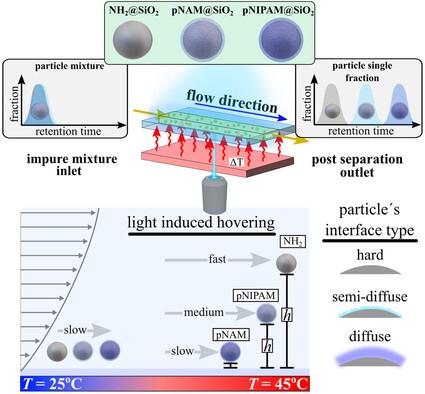Separation of Surface Grafted Microparticles via Light and Temperature
IF 11.1
Q1 MATERIALS SCIENCE, MULTIDISCIPLINARY
引用次数: 0
Abstract
Separation of equally sized particles distinguished solely by interfacial properties remains a highly challenging task. Herein, a particle fractioning method is proposed, which is suitable to differentiate between polymer-grafted microparticles that are equal in size. The separation relies on the combination of a pressure driven microfluidic flow, together with simultaneous light illumination and temperature control. Heating the solution forces thermo-responsive surface grafts to undergo a volume phase transition and therefore locally changing the interfacial properties of the microparticles. Light illumination induces the phoretic/osmotic activity of the microparticles and lifts them into a higher plane, where hovering particles experience a different shear stress proportional to the height. The light-induced hovering height depends on the interfacial properties, and this complex interaction leads to different movements of the microparticles as a function of their surface grafting. The concepts are visualized in experimental studies, where the complex physical principle provides a simple method for fractioning a binary mixture with at least one thermo-responsive polymer graft.

通过光和温度分离表面接枝微颗粒
仅凭界面特性来区分大小相同的颗粒仍然是一项极具挑战性的任务。本文提出了一种颗粒分馏方法,适用于区分聚合物接枝的大小相同的微颗粒。这种分离方法依赖于压力驱动的微流体流动,以及同时进行的光照和温度控制。加热溶液会迫使热响应表面接枝发生体积相变,从而局部改变微颗粒的界面特性。光照会诱发微颗粒的相变/渗透活动,并将它们提升到一个较高的平面上,在这个平面上悬浮的颗粒会受到与高度成正比的不同剪应力。光诱导的悬浮高度取决于界面特性,这种复杂的相互作用导致微颗粒因表面接枝而产生不同的运动。实验研究将这些概念形象化,复杂的物理原理提供了一种简单的方法,用于分馏至少有一种热响应聚合物接枝的二元混合物。
本文章由计算机程序翻译,如有差异,请以英文原文为准。
求助全文
约1分钟内获得全文
求助全文
来源期刊
CiteScore
14.00
自引率
2.40%
发文量
0
期刊介绍:
Small Science is a premium multidisciplinary open access journal dedicated to publishing impactful research from all areas of nanoscience and nanotechnology. It features interdisciplinary original research and focused review articles on relevant topics. The journal covers design, characterization, mechanism, technology, and application of micro-/nanoscale structures and systems in various fields including physics, chemistry, materials science, engineering, environmental science, life science, biology, and medicine. It welcomes innovative interdisciplinary research and its readership includes professionals from academia and industry in fields such as chemistry, physics, materials science, biology, engineering, and environmental and analytical science. Small Science is indexed and abstracted in CAS, DOAJ, Clarivate Analytics, ProQuest Central, Publicly Available Content Database, Science Database, SCOPUS, and Web of Science.

 求助内容:
求助内容: 应助结果提醒方式:
应助结果提醒方式:


